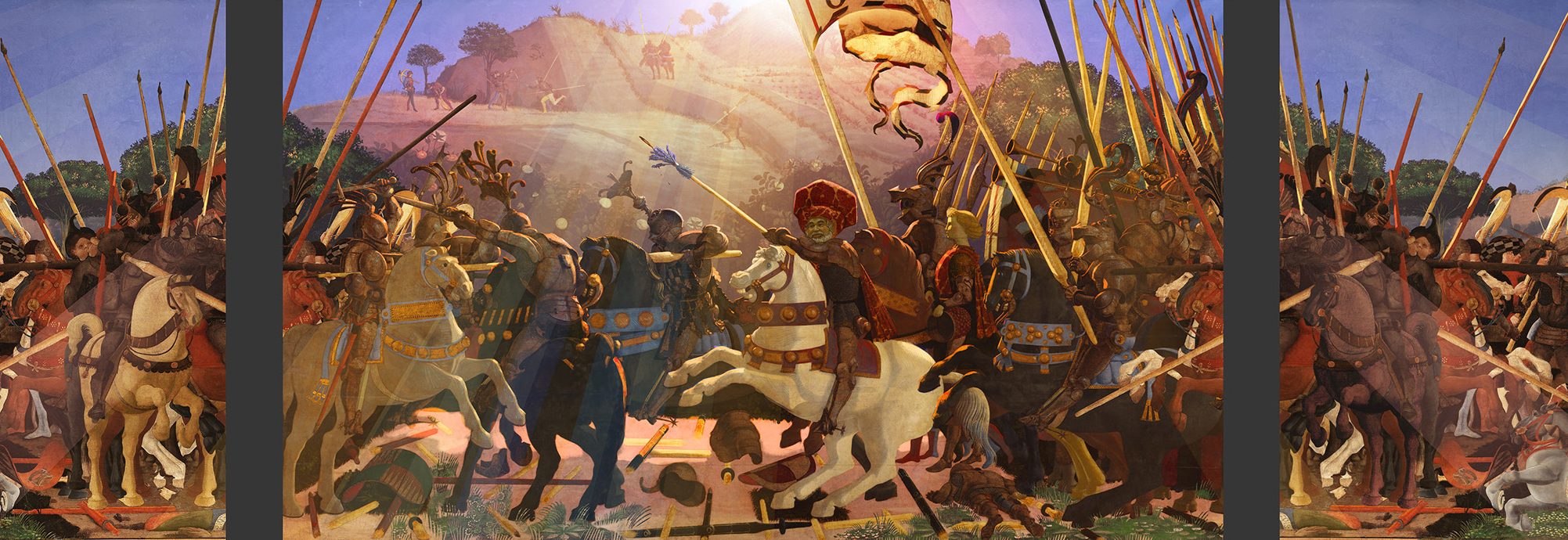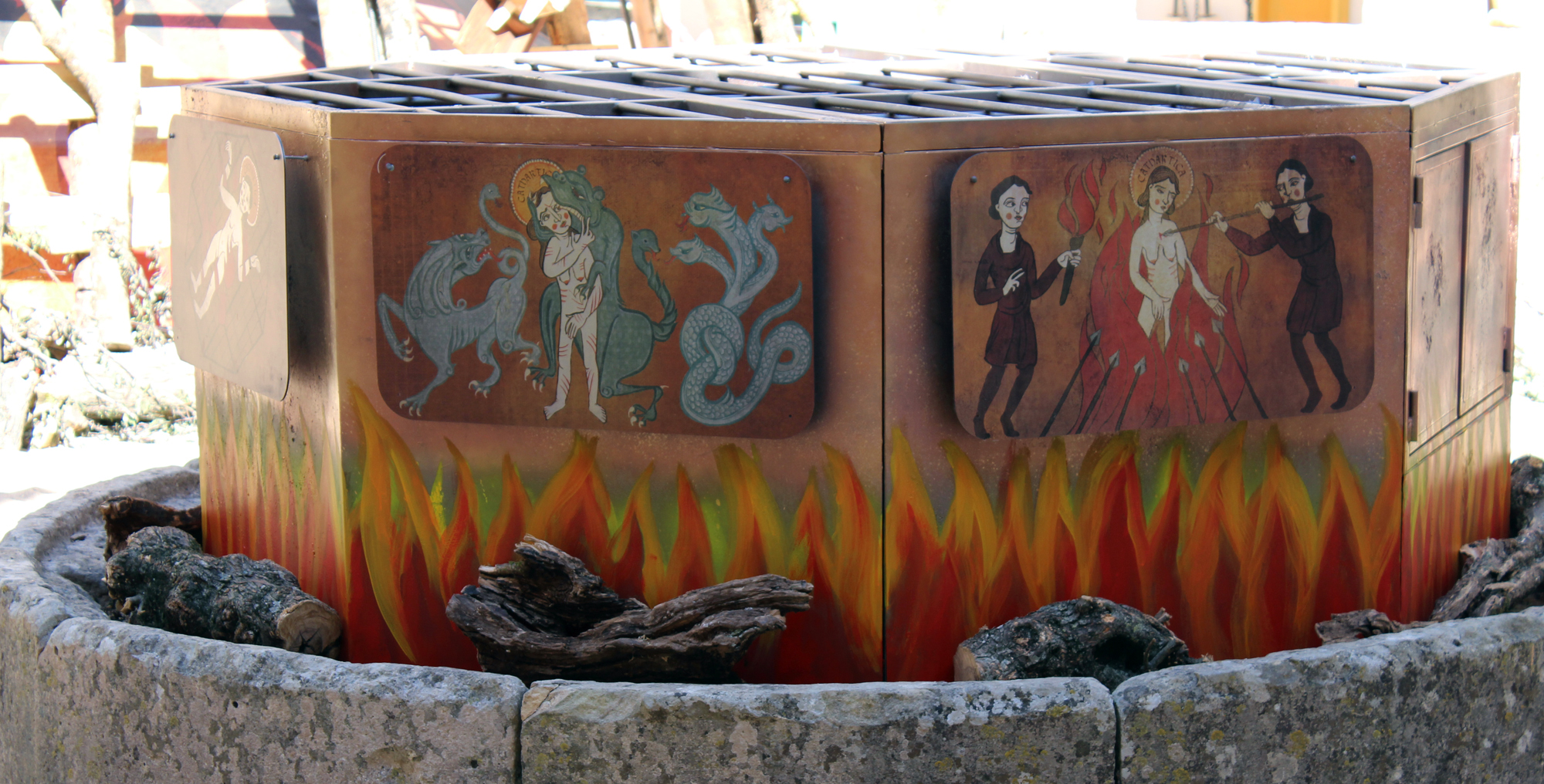
PRODUCTION STORY - CHAPTER THREE
Click here for Production Story, Chapter Two
THE LOOK OF THE FILM
The Man Who Killed Don Quixote’s production design was led by Benjamín Fernández, who had the same role on the 2000 attempt to make the picture. Terry Gilliam drew visual inspiration from the artists Goya and Doré. “Goya is in this picture,” says the director, “His work is extraordinary, and it is Spanish of course. Doré illustrated Quixote in the 19th century, and his images have always stuck with me. It’s this battle between Doré’s precise images of Quixote and his world, and the dark, phantasmagorical and disturbing world of Goya.”
A key scene in the picture is where Toby and Angelica meet with Alexei. Gilliam wanted to establish the sense of a hunt, and initially thought of a unicorn and other colossal images of animals to decorate the walls. Then Fernández suggested inspiration from Italian Renaissance artist Uccello. Gilliam knew who could assist: artist Daniele Auber, with whom the director had previously collaborated. Auber created a full-scale digital painting based on Uccello’s work, using Photoshop, which was then printed on canvas, creating the impression that it is night-time on one side of the room and daytime on the central panel.
Other notable art department coups included the statue of Cathartica and the transformation of a convent into a party venue. The giant 3-dimensional image was inspired by those built for Valencia’s Las Fallas festival, constructed by local communities. They are satirical, political, religious, and incredible,” explains Gilliam. “They are made from papier-mâché, and they are huge, elaborate figures. They stand for a week throughout the town and then on the last night they’re all burnt. On our Cathartica’s big conical skirt we hung the things that people don’t want any more. They sacrifice their consumer goods on Santa Cathartica.” The huge statue had to be constructed in Madrid and then divided into pieces, to be transported to Tomar and rebuilt in the convent’s cloister.
Leading the set decoration team was Edou Hydallgo. The biggest challenge he faced was to create the party setting. He described the convent as a “labyrinth of beauty”, and explains his concept, “We have, here in the film, a rich person with no artistic sensibility, but he has a lot of money, so can bring artists and designers from New York, Milan or Paris to create a big, big party.” Gilliam has great admiration for the work Hydallgo performed, saying, “All of the fabric artworks were created by Edou and his team. They are their own invention. They are not the kind of thing I would have ever designed, I’m not capable of it, but they are breathtakingly beautiful.”
Terry Gilliam’s long-term collaborator and director of photography, Nicola Pecorini, also worked on the aborted Quixote shoot in 2000, and on every subsequent attempt, including this one. Pecorini says, “Terry is Quixote, and unfortunately I feel very much like Sancho. I just follow him. I’m glad I did, but if I think of it, it was completely crazy. I gave up so many jobs over the years to try to do this one!”
The pair opted to use digital cameras, which made this the first Gilliam feature film to be shot this way. The decision was made, due to the long time it would have taken to process the film. Says Pecorini, “Film is cheaper, and the problem with digital is that you have to even out everything. And the digital cameras are cumbersome. Yet, in Spain, there are no labs left. And the labs that are available, such as in France, Belgium or London, do not work overnight, or through the weekend. Therefore, if we were shooting the last day on a location, on film, on a Friday, we wouldn’t know if everything was all right until Tuesday.”
Yet, at the same time, in order to keep something more cinematic, Pecorini insisted on going anamorphic. He obtained Technovision lenses designed by Henryk Chroscicki and Beppe Magni. “In the mid-‘70s they were made for Vittorio Storaro’s needs on Apocalypse Now (1979). They are old lenses but are one of a kind. They have been used on quite a lot of great movies, and I worked with them many times, including on The Last Emperor (1987). They give Quixote an epic dimension.” And Pecorini was delighted with his Spanish crew, saying, “My gaffer was a genius, and the electric crew were great. The grips were the same, and the camera team were brilliant.”
Costume designer Lena Mossum became involved with The Man Who Killed Don Quixote out of a love not only for the script, but also for the director’s previous work. Yet, what most fascinated Mossum, was that the picture is a mixture of a period film and a contemporary film, and it therefore allowed her to play with and combine the ancient with the modern. This is most apparent in the party scenes at the Mishkin Palace, where there is a riot of costume from many different influences. Gilliam was delighted with the result, saying “I don’t know how Lena’s done it, but it’s beautiful and flamboyant.”
Mossum is particularly pleased with the unique costume for the Knight of The Mirrors. She says, “I thought that, instead of mirrors, why don’t we use compact discs?” So, the costume team went to work collecting and arranging CD fragments. “It’s an explosion of different colours,” enthuses Gilliam. To complete the look for the mirrored knight, he needed a helmet, which Mossum insisted on crowning with the horns of a Spanish bull.
Some eagle-eyed cinemagoers may notice a similarity between Quixote’s costume in this version and the costume Jean Rochefort wore in the 2000 attempt, as seen in Lost in La Mancha. Jonathan Pryce, who inhabited the costume, reveals, “It’s true. We managed to get the originals.” Gilliam explains what happened: “Nicola Pecorini just happened to be on the phone to Carlo Poggioli, who had been Gabriella Pescucci’s assistant when we were first making the film. Earlier that day, he had actually opened the box containing the Quixote costume, because he was thinking of using it in an opera. We called Gabriella, and she was delighted that it would finally be used in the film. With Lena doing some adjustments, it fitted Jonathan perfectly.”
Heading up the make-up and hair unit was Sylvie Imbert, who loved the script and wanted to work with Gilliam. She recalls, “I could see the opportunity to do lots of different things in the movie, yet I didn’t know if we would have enough time to prepare! Working with Terry is an honour, because I admire him – I am happy just to work with him. It’s a challenging experience, because he pushes you to the point where he can get the best of you. You do something and then he always wants more and more.”
Make-up and hair were instrumental in creating the fantastic world of The Man Who Killed Don Quixote. As the director points out, “One of the most important aspect of this film was to get a good nose on Jonathan. He has a lovely little nose, but it’s not the hawk-beak that Quixote must have: the prow of a boat, ploughing its way through the seas of disaster. And we’ve got a very good one.”
Pablo Perona, of May Effects in Barcelona, created the prosthetic. He spent almost an hour each day applying it to Jonathan Pryce, to make an authentic-looking Quixote. Pryce says, “Pablo is an absolute master of the craft of the fake nose. You cannot see the join, and I am completely unaware of it when it’s on. I like working with a beard, but to also have the mask of a nose to hide behind, is always a good thing for an actor.”
For the party in the Mishkin palace, Imbert and her team were given a great deal of freedom. Says Gilliam, “They did all sorts of incredible, outrageous hairstyles. They were amazing. We just let Sylvie and her team get on with it, because they were coming up with really good, interesting ideas, so I just stayed out of their way, and let them play and have a good time!”
Olga Kurylenko developed a rewarding relationship with Imbert, saying, “The hair and make-up team on the movie were fantastic and made me look like a different person. I’ve never been blonde in a movie before, and we had plenty of opportunities to play with a variation of styles throughout the film. We had many different opportunities to change it: we do special make-up for the party; there is Jacqui in her normal life; there’s sad Jacqui; and there’s Jacqui when she dresses up, so we developed different types of crazy make-up, since Jacqui’s a very chic woman.”
Click here for Production Story, Chapter Four


